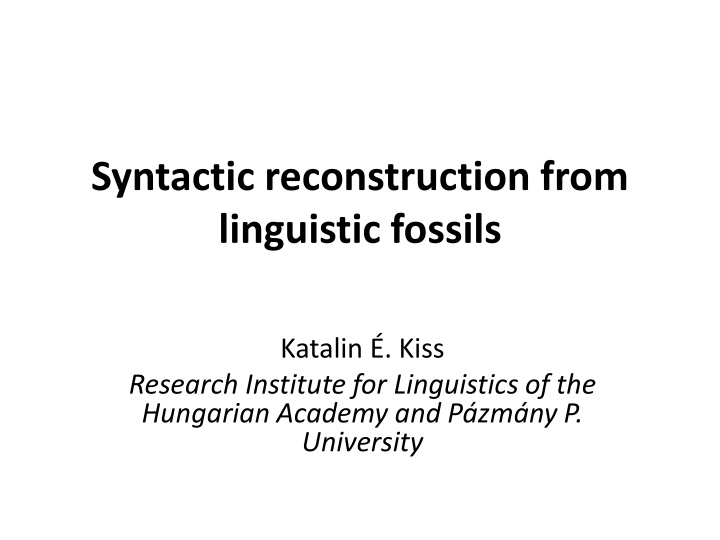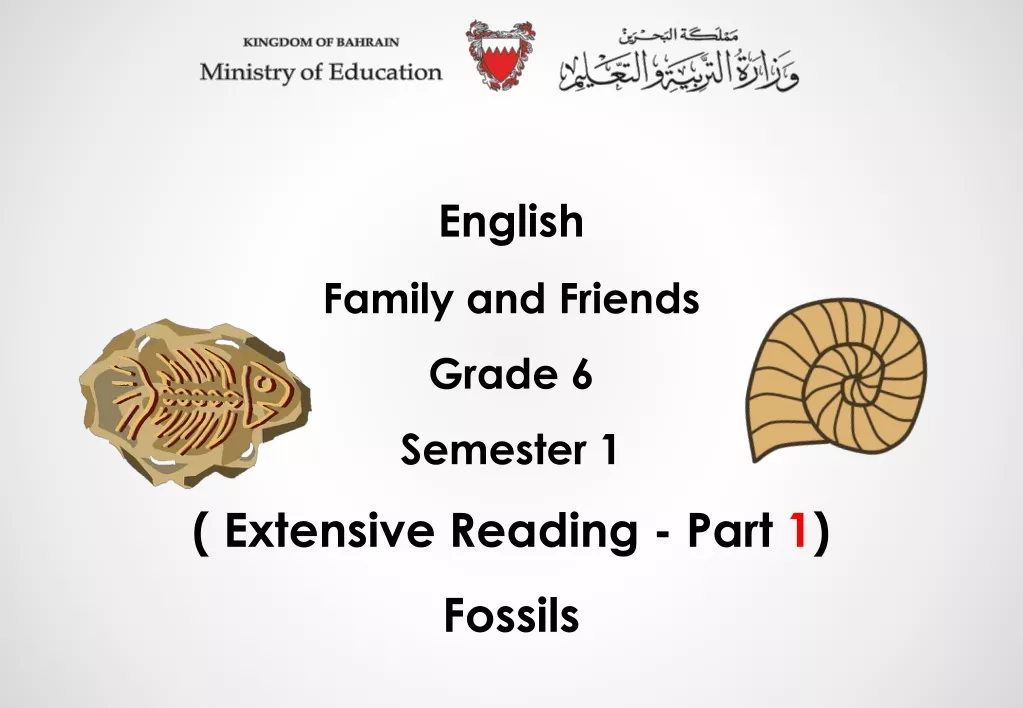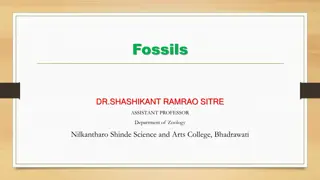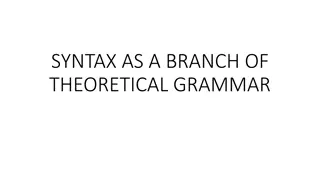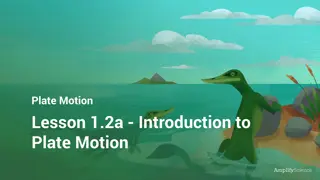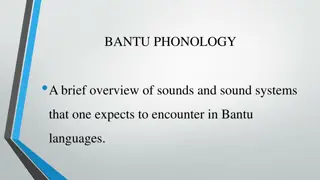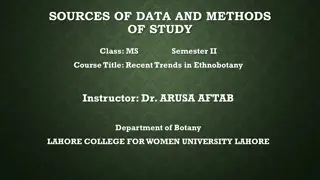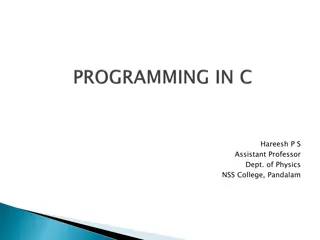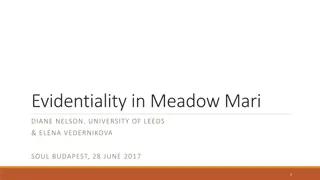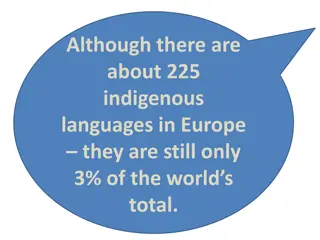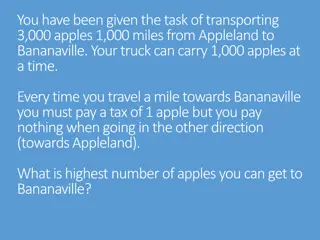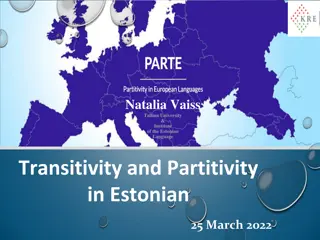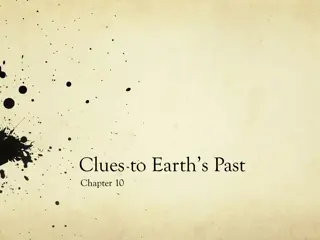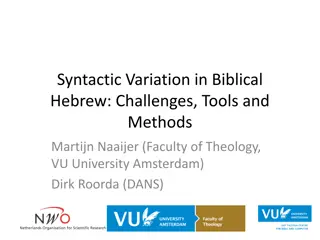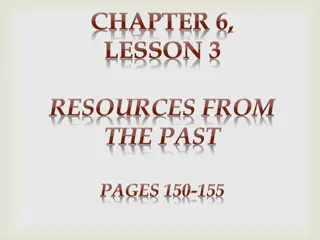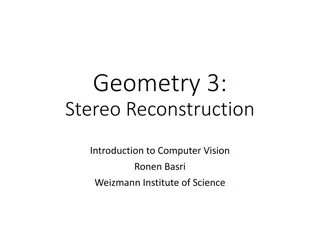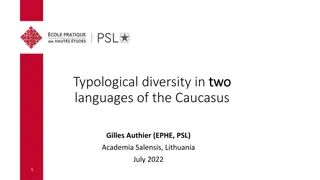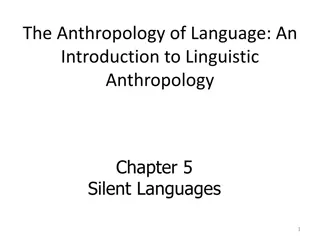Syntactic Reconstruction from Linguistic Fossils in Uralic Languages
Linguistic fossils provide valuable insights for syntactic reconstruction in Uralic languages like Hungarian, Eastern Khanty, and Samoyedic. Through a case study, constraints on topical objects and grammatical systems are examined using linguistic fragments.
Download Presentation

Please find below an Image/Link to download the presentation.
The content on the website is provided AS IS for your information and personal use only. It may not be sold, licensed, or shared on other websites without obtaining consent from the author.If you encounter any issues during the download, it is possible that the publisher has removed the file from their server.
You are allowed to download the files provided on this website for personal or commercial use, subject to the condition that they are used lawfully. All files are the property of their respective owners.
The content on the website is provided AS IS for your information and personal use only. It may not be sold, licensed, or shared on other websites without obtaining consent from the author.
E N D
Presentation Transcript
Syntactic reconstruction from linguistic fossils Katalin . Kiss Research Institute for Linguistics of the Hungarian Academy and P zm ny P. University
Claim Linguistic fossils are potential sources of syntactic reconstruction. A fossilized linguistic fragment provides reliable information on a proto-construction if it can be fit together with other fragments preserved in the given language and/or in the sister languages.
A case study: Fitting together fragments preserved in Uralic languages Hungarian, Eastern Khanty, Samoyedic: Inverse Agreement Constraint Khanty, Mansi, Samoyedic: Differential Object-Verb Agreement Hungarian, Eastern Mansi: Person-Case Constraint Eastern Mansi: Differential Object Marking
The grammatical system to be reconstructed from the fragments: Topical objects marked by - agreement on the verb, and - a case suffix on the object. The constraints regulate the relative topicality of the subject and the object: the object can t be more topical than the subject.
Fragment 1: Inverse Agreement Constraint in Hungarian Verbal agreement with 3rd person objects; no agreement with 1st/2nd person objects: (1) J nos l t-ja- John (2) J nos l t- John (3) J nos l t- John t/ ket. him/them see-OBJ-3SG engem/minket. me/us t ged/titeket. yousg/youpl see-3SG see-3SG
A weak (relativized) constraint: S3 < O2: (4) he l t- see-3SG t ged. you.ACC S1 > O2: (5) n I l t-l-ak see-2OBJ-1SG t ged. you. S3 < O1: (6) he l t see.3SG engem. me S2 < O1: (7) Te you see-2SG l t-sz engem. you.ACC
A weak (relativized) constraint: S1SG > O1PL: O-V agr (8)a. n minket aj nl-om I us recommend-OBJ.1SG/recommend-1SG I recommend us. /*aj nl-ok. S2SG > O2PL: O-V agr b. Te youSGyouPL-2PL-ACC recommend-OBJ-2SG/rec.-2SG Do youSGrecommend you guys? titeket aj nl-od /*aj nl-asz?
A weak (relativized) constraint : S1PL > O1SG: no O-V agr (9)a. Mi engem v laszt-unk/*v laszt-ju-k. we me elect-1PL We elect me. /elect-OBJ-1PL S2PL > O2SG: no O-V agr b. Ti t ged youPLyouSG Do you guys elect youSG? v laszto-tok/*v laszt-j -tok? elect- 2SG /elect-OBJ-2SG
The Inverse Agreement Constraint (IAC) (Comrie 1980) (10) Inverse Agreement Constraint An object agreeing with a verb must be lower in the animacy hierarchy than the subject agreeing with the same verb. (11) Animacy hierarchy 1SG > 1PL > 2SG > 2PL > 3SG > 3PL
(12) Animacy Hierarchy (Hungarian) 1PL 1SG > 2SG > 2PL > 3 speaker participant non-participant (13) Inverse Agreement Constraint (Hungarian) An object agreeing with a verb must be lower in the animacy hierarchy than the subject agreeing with the same verb, unless both the subject and the object represent the lowest level of the animacy hierarchy.
Strong IAC in Eastern Khanty, Samoyedic: no agreement with 1st and 2nd person objects (14) Vera w-at Vera she-ACC Vera knows her. w - -t . know-PRS-OBJ.3SG (15)a. w m n-t /n -at he I-ACC /you-ACC He sees me/you. w - . see-PRS.3SG b. m n -at I I see/know youSG. w - - m. see-PRS-1SG you-ACC
Strong IAC also in Tundra Nenets (Dalrymple and Nikolaeva 2011): lad -da. hit- OBJ.3SG (16) Wanya syita John he. ACC John hit him. (17) Wanya syiqm /syit John John hit me/you. lad /*lad -da I.ACC/you.ACC hit.3SG/hit- OBJ.3S
Fragment 2: Differential object-verb agreement in Uralic (Ugric & Samoyedic) Optional definite O V agreement? (18)a. ku rit tu-s man boat take-PAST.3SG man The man took a boat. b. ku rit tu-s-t man boat take-PAST-OBJ.3SG The man took the boat. (Khanty)
Nikolaeva (1999; 2001), Dalrymple & Nikolaeva (2011): O-V agreement in Khanty and in the Samoyedic languages (Tundra Nenets, Selkup, Nganasan) iff O is given, topical: (19)a. [TopPS [VPO V+AgrS ]] b. [TopPS [TopPO [VPV+AgrO+AgrS ]]]
(Eastern) Uralic sentence structure: SOV, with S = primary topic (20)a. (luw) juwan Ivan re:sk- s hit- PAST.3SG he He hit Ivan. b. juwan Ivan Who was Ivan hit by? xoj-na who-LOC re:sk- s-a hit-PAST-PASS.3SG (Khanty)
(Eastern) Uralic sentence structure: SOV, with S = primary topic (21)a.*xoj tam xu:j an who this man not see-PAST.3SG Nobody saw this man. b. tam xu:j xoj-na this man who-LOC not see-PAST-PASS.3SG This man was not seen by anybody. wa:nt- s an wa:n-s-a (Khanty)
Object conveying new information: (22)a. What happened? ma tam kala I this reindeer kill-PAST-1SG/kill-PAST-OBJ.1SG I killed this reindeer. we:l-s- m /*we:l-s-e:m Given object: b. What did you do with this reindeer? ma tam kala I this reindeer I killed this reindeer. *we:l-s- m kill-PAST-1SG/kill-PAST-OBJ.1SG (Khanty) /we:l-s-e:m
(23) Presupposed object: Ma ta:l x I mushroom here collect-PRES-OBJ.1SG not there I collect mushrooms HERE, not THERE. ta:ta a:k t-l-e:m anta to:ta A new O with a familiar possessor counts as given: (24) Luw kala - l re:sk- s-li he reindeer-3SG hit-PAST-OBJ.3SG Heihit hisi/*jreindeer.
OV agreement with familiar objects also in IO-shift constructions: (25)a. Am mis-um-n I I cut hay for my cow. pum s r- -um cut-PRES-1SG cow-1SG-DAT hay b. Am mis-um pum-el I cow-1SG hay-INSTR cut-PRES-OBJ-1SG I supply my cow WITH HAY. s r-i-l-um (Northern Mansi)
The Inverse Agreement Constraint is an Inverse Topicality Constraint (26) Inverse Topicality Constraint A secondary topic cannot be more topical than the primary topic of the same clause. (27) An object more topical than the subject of the same clause can only be construed as a focus. Hungarian: topical-O V agreement definite-O V agreement The Inverse Topicality Constraint is a linguistic fossil.
Fragment 3: Differential object marking in Uralic Eastern Mansi: O case-marked iff secondary topic: (28) a. kom jowt-ny l man bow-arrow The man took a bow and an arrow w -s take-PAST b. w-m door-ACC I can t find the door. t kont-iil m NEG find-OBJ.1SG
Fragment 4: A Person-Case Constraint 1st and 2nd person objects are caseless: (29) n- m I-1SG Kill me! j l- l- l- n. down-kill-IMP-OBJ.2SG (30) Om n -n jor l I you-2SG on.purpose bring-PAST-OBJ.1SG here I brought you here on purpose. (Eastern Mansi) t t- s-l m t g.
Objects anchored to a 1st/2nd person possessor are caseless: (31) k- n uncle-2SG how How could you leave your uncle! (E Mansi) kom ly wo xtl- s-l n! leave- PAST-OBJ.2SG A possessive suffix doesn t exempt from accusative marking: (32) s gr p- t m kont- s-t . axe-3SG.ACC He found his axe. find-PAST-OBJ.3SG
Functions of non-possessively used possessive agreement morphemes in Uralic: (i) 3rd person: identifying, deictic role; (ii) 1st/2nd person: associative role; the speaker/addressee is the reference point; (iii) the possessive ending can express contrast.
Hungarian: generalized object marking; the Inverse Object Marking Constraint is a linguistic fossil No accusative -t on SG1,2 objects: (33) SG1: eng-em I-POSS1SG vs. we-POSS1PL-ACC PL1: mi-nk-et SG2: t g-ed you-POSS2SG PL2: ti-tek-et youPL- POSS2PL-ACC SG3: -t (s)he-ACC PL3: -k-et (s)he- PL-ACC
If O has a 1SG or 2SG possessor, the accusative -t is optional: (34) sszet rt k az aut -m(-at) broke-3PL They broke my car/your car. /aut -d(-at). the car- POSS1SG(-ACC)/POSS2SG(-ACC)
Piecing together the surviving fragments: Proto- Uralic Samoyedic N Khanty E Khanty E Mansi Hungarian Topical O V agreement Inverse Agreement Constraint Topical O marking Inverse O Marking Constraint + + + + + + + + + + + + + +
The Proto-Uralic System i. Differential Object-V agreement: V+AgrO+AgrS iff O is secondary topic ii.Inverse Agreement Constraint (=PCC): *V + AgrO1/2 + AgrS3 Repair: V+AgrS3 iii. Differential Object marking: O + ACC iff O is secondary topic iv. Inverse Object-marking Constraint (=PCC) *O1/2+ACC *O+POSS1/2+ACC Repair: O1/2 O+POSS1/2
Reconstructing the function of the Proto-Uralic system: In Khanty, Mansi and Samoyedic, verbal agreement is topic-doubling cf. Giv n (1975), Farkas & Kazazis (1980), Kallulli (2008), Do ekal & Kallulli (2012); In Eastern Mansi, also object-marking marks the topic position of the object cf. Enc (1991), Dalrymple & Nikolaeva (2011) differential O-V agreement and differential O- marking encod(ed) the topic status of the O.
The Inverse Agreement Constraint and the Person-Case Constraint are manifestations of an Inverse Topicality Constraint. (35) Inverse Topicality Constraint The hierarchy of topicalized constituents in the same (external or internal) structural domain should not contradict their ranking in the hierarchy of discourse participants.
Standard explanations of the Person-Case constraint: two arguments attempt feature checking with the same probe B jar & Rezac (2009): the internal and external argument compete for agreement with the v node. First downward search, then upward search. PCC: A probe with completely valued features is inactive for upward agreement. A 1st person internal argument (speaker, participant, person) leaves no features to be checked.
The reconstructed system provides evidence against the feature checking explanation: Why is O-marking blocked in Eastern Khanty and Hungarian in the case of objects with a 1st or 2nd person possessor? Because what triggers the PCC is not the interaction of the person features of S and O but the discourse hierarchy of their referents. (An O with a 1st/2nd person possessor is a part, or a belonging, of the speaker or the listener. )
Conclusion: Linguistic fossils are potential sources of syntactic reconstruction. The Eastern Uralic languages had differential object-verb agreement and differential object marking. They encoded the topic role of the object. The Inverse Agrement Constraint and the Person-Case Constraint ensured that the structural hierarchy of topics do not contradict their hierarchy in the animacy scale. The PCC of the Indo-European etc. languages may have had the same function.
Selected references Dalrymple, Mary & Irina Nikolaeva 2011. Objects and Information Structure. CUP. Docekal Mojm r & Kallulli 2012. More on the semantics of clitic doubling. In Empirical Issues in Syntax and Semantics 9, ed. by C. Pinon, 113 128. Mouton. http://www.cssp.cnrs.fr/eiss9/ . Kiss, Katalin 2005. The inverse agreement constraint in Hungarian a relic of a Uralic Siberian Sprachbund? In Organizing Grammar. Linguistic Studies in Honor of Henk van Riemsdijk, ed. by Hans Broekhuis et al, 108-116. Mouton. . Kiss, K. 2012. Null pronominal objects in Hungarian. Acta Linguistica Hafniensia 44: 92-206. . Kiss, Katalin 2013. The Inverse Agreement Constraint in Uralic Languages. Finno-Ugric Languages and Linguistics 2 (1): 2-21. Kallulli, Dalina. 2008. Clitic doubling, agreement, and information structure. In Clitic doubling in the Balkan languages, ed. by D. Kallulli & L. Tasmowski, 227 255. Amsterdam: Benjamins. Nikolaeva, I. 2001. Secondary topic as a relation in information structure. Linguistics 39: 1-49. Nikolaeva, Irina 2002. Possessive affixes in the pragmatic structuring of the utterance: Evidence from Uralic. In International Symposium on Deictic Systems and Quantification, Izhevsk, ed. by Bernard Comrie & Pirkko Suihkonen. Benjamins. Nikolaeva, Irina 2014. A Grammar of Tundra Nenets. Berlin: Mouton de Gruyter. Sip cz, Katalin 2012. Ditranzit v ig k a manysiban. Nyelvtudom nyi K zlem nyek 109: 123-136. Virtanen, Susanna 2014. Pragmatic object marking in Eastern mansi. Linguistics 52: 391 413. Virtanen, Susanna 2015. Transitivity in Eastern Mansi. PhD dissertation. University of Helsinki.
